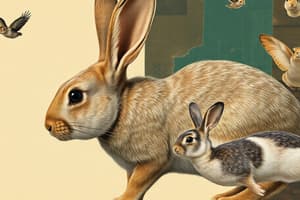Podcast
Questions and Answers
What marks the beginning of a typical rabbit breeding cycle?
What marks the beginning of a typical rabbit breeding cycle?
- High pregnancy rate
- Eggs released during previous ovulations
- Swollen and moist vulva (correct)
- Giving birth
Why do female rabbits have a short reproductive cycle compared to other species?
Why do female rabbits have a short reproductive cycle compared to other species?
- Low pregnancy rate
- Long gestational periods
- High reliance on external fertilization
- High internal fertilization rate (correct)
During which stage of the rabbit breeding cycle do the eggs released during previous ovulations develop into embryos if fertilized?
During which stage of the rabbit breeding cycle do the eggs released during previous ovulations develop into embryos if fertilized?
- Diestrus (correct)
- Anoestrus
- Proestrus
- Estrus
What characterizes the estrus stage in the rabbit breeding cycle?
What characterizes the estrus stage in the rabbit breeding cycle?
How many stages are there in a typical rabbit breeding cycle?
How many stages are there in a typical rabbit breeding cycle?
After giving birth, what stage follows in the rabbit's breeding cycle?
After giving birth, what stage follows in the rabbit's breeding cycle?
What behavior do male rabbits typically exhibit when they meet head-on to establish dominance?
What behavior do male rabbits typically exhibit when they meet head-on to establish dominance?
How does the more dominant buck usually behave when faced with aggression?
How does the more dominant buck usually behave when faced with aggression?
What is a common practice to prevent injuries among mating rabbits?
What is a common practice to prevent injuries among mating rabbits?
What happens when a buck successfully achieves intromission during mating?
What happens when a buck successfully achieves intromission during mating?
What is the average gestational period for rabbits after successful breeding?
What is the average gestational period for rabbits after successful breeding?
How many offspring can typically be in a litter of rabbits?
How many offspring can typically be in a litter of rabbits?
Flashcards are hidden until you start studying
Study Notes
Rabbit Breeding in Agriculture
Rabbits have been domesticated since ancient times and serve various purposes today, including meat production, fur farming, and companionship. In agricultural settings where rabbits are bred for their protein-rich meat, understanding their breeding cycles is crucial for efficient management of populations and optimal utilization of resources. Here's what you need to know about rabbit breeding in terms of reproductive physiology, breeding cycles, mating, and gestational periods.
Reproductive Physiology
The female rabbit, also known as a doe, has a short reproductive cycle compared to other species due to its high pregnancy rate. This is primarily because they rely heavily on internal fertilization, which means it happens without external stimulus during copulation. After copulating once with one male, a single ejaculate can produce several litters from different females.
Breeding Cycles
A typical rabbit breeding cycle consists of four stages: proestrus, estrus, diestrus, and anoestrus. Proestrus marks the beginning when the vulva becomes swollen and moist, indicating impending ovulation within days. Estrus follows this stage, characterized by heightened sexual activity and readiness for mating. During diestrus, the eggs released during previous ovulations develop into embryos if fertilized; otherwise, they degenerate. Anoestrus occurs after giving birth, so there may be some time between successive pregnancies depending on the age of the doe.
Mating
Males, referred to as bucks, often exhibit aggressive behavior towards does, as well as toward each other when competing over access to them. To prevent injuries, it's common practice to keep males separated unless they are being introduced to new does for breeding purposes. When two bucks meet head-on, they typically sniff nose to nose until one turns away, signaling submission. If aggression persists, the more dominant buck will stand tall while the less dominant one may flatten his ears, lower his head, crouch down with legs stretched out behind him, and sometimes urinate. These behaviors help establish dominance hierarchy among males, ensuring orderly access to does.
During mating, the buck mounts the doe from behind, gripping her shoulders with his front paws and using his hind limbs to thrust against her hindquarters. Female rabbits have a relatively small vaginal opening, making penetration difficult. It's not uncommon for a buck to make multiple attempts before successfully achieving intromission. Once inside the vagina, the penis swells up, blocking further sperm entry until ejaculation takes place.
Gestational Periods
After successful breeding, the average gestational period for a rabbit ranges from 31 to 34 days. However, first-time mothers may carry their young longer, averaging around 37 days. A litter usually comprises 8–9 offspring, although anywhere from 1 to 26 kits can be born.
In conclusion, understanding the nuances of rabbit reproduction is essential for effective management practices on farms raising these animals for food products. By observing their natural behaviors and reproductive patterns, farmers can optimize their operations, ensuring healthy growth rates while minimizing stress on both individuals and groups of rabbits under their care.
Studying That Suits You
Use AI to generate personalized quizzes and flashcards to suit your learning preferences.




